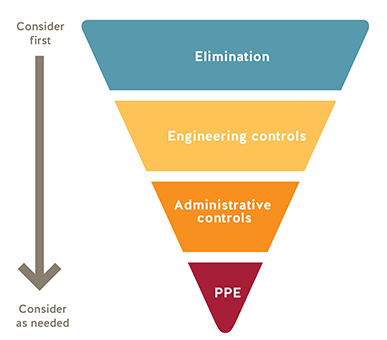Please note: The templates provided below are intended as resources and guidance materials. They may be adapted as necessary to reflect the specific needs of the process being captured.
The Health and Safety (H&S) team is available to provide consultation and support at any stage of this work. You can reach us at safety@flemingcollege.ca for guidance or questions.
Regardless of whether consultation is sought, all final drafts must be reviewed and approved by department leaders and then submitted to the H&S team.
These templates are designed to streamline processes and help mitigate risks associated with particular tasks or areas. Remember that different protocols provide varying levels of protection. Wherever possible, select the protocols that offer the highest level of protection and supplement them with additional controls as required. When developing your plans, you may refer to the standard hierarchy of controls as a framework.
First level protection (elimination): Limit the number of people in your workplace where possible by implementing work-from-home arrangements, establishing occupancy limits, rescheduling work tasks, or other means. Rearrange workspaces to ensure that workers are physically distanced, according to public health measures, from co-workers, customers, and members of the public.
Second level protection (engineering controls): If you can’t always maintain physical distancing, install barriers such as plexiglass to separate people.
Third level protection (administrative controls): Establish rules and guidelines, such as cleaning protocols, telling workers to not share tools, or implementing one-way doors or walkways.
Fourth level protection (PPE): If the first three levels of protection aren’t enough to control the risk, consider the use of masks. Ensure masks are selected and cared for appropriately and that workers are using masks correctly.
Standard Operating Procedure
Standard Operating Procedures (SOPs) are documents that provide step-by-step guidance to a specific activity. SOPs ensure consistency in execution of procedures and highlight key associated safety notes. SOPs ensure procedures are completed efficiently and meet workplace quality standards.
Job Safety Analysis
A Job Safety Analysis (JSA) is a procedure of breaking down a job/task into specific steps to assist in identifying potential risks and hazards.
Risk Assessment
Risk assessments are used to observe a specific task, activity, or process and determine associated hazards and potential controls. A risk assessment is a key part of the RACE process for dealing with hazards: Recognize, Assess, Control and Evaluate.
PPE Assessment Form
The PPE Assessment Form can be used to determine the required PPE for a task, process, or activity by identifying associated hazards.
Safety Data Sheets/Hazardous Materials Inventory
Please use the SDS/Hazardous Materials Inventory template to gather information from chemicals or other hazardous materials. Once completed, send to the Health and Safety team to add associated safety data sheets to the eBinder.
Hazardous Waste Inventory
Please use the hazardous waste inventory ahead of hazardous waste pickups and send to safety@flemingcollege.ca for approval once complete. Visit the Hazardous Materials Pickups page for more information.
Lab Safety Inspection Checklist
High hazard labs are required to be inspected monthly and a copy of the inspection is to be posted on the Safety Board. This template should be customized to your lab space. Once complete, email the inspection to the Health and Safety team for review. Visit the Safety Information Boards page for more information.
For any questions or concerns, please contact safety@flemingcollege.ca
